The Aby Guitar Pedal is a crucial tool for guitarists looking to expand their sonic palette by using multiple amplifiers. But what exactly is an ABY pedal, and how can it benefit your guitar rig? Simply put, an ABY switcher allows you to send the signal from your guitar to two amplifiers. The “AB” part lets you switch between amp A or amp B, while the “Y” function enables you to run both amps simultaneously. Connecting your guitar or pedalboard output to an ABY pedal is straightforward, with outputs then feeding into your chosen amplifiers. However, simply plugging in and playing can sometimes lead to unwanted noise, tonal issues, and even electrical hazards. Let’s delve deeper into the world of ABY guitar pedals to understand how to use them effectively and avoid common problems.
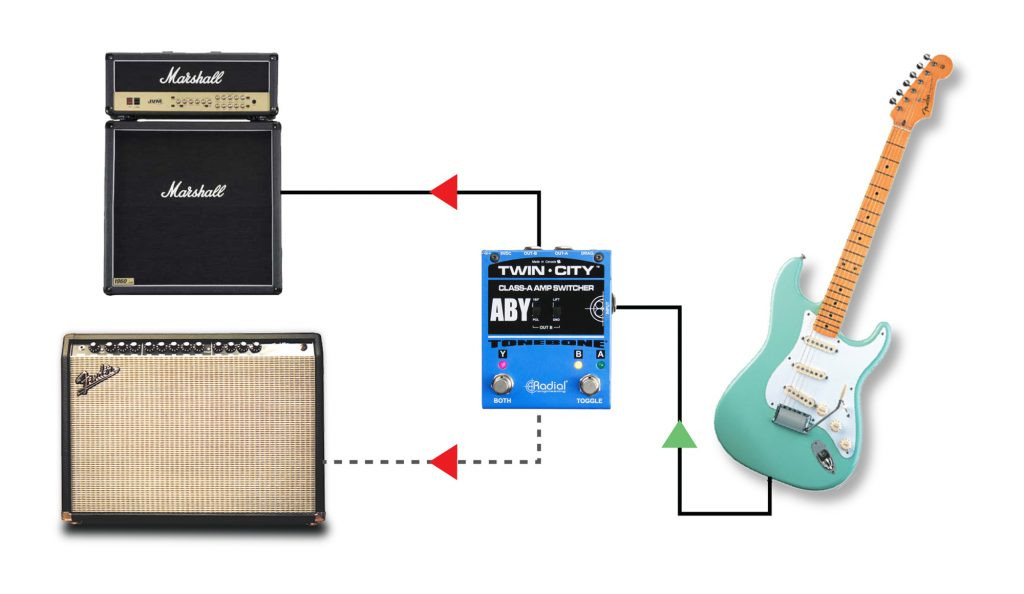 ABY Switcher Signal Path
ABY Switcher Signal Path
Alt text: ABY guitar pedal signal path diagram showing input from guitar and outputs to amplifier A and amplifier B, illustrating amp switching and simultaneous operation.
Passive vs. Active ABY Pedals: Which is Right for You?
When shopping for an aby guitar pedal, you’ll primarily encounter two types: passive and active. The fundamental difference lies in their power requirements and signal management.
Passive ABY pedals are the simpler of the two. They operate without needing an external power source. Think of them as direct mechanical switches that reroute your guitar signal. They don’t incorporate any internal circuitry to buffer or modify the signal. Some guitarists who prioritize a pure, unaltered tone prefer passive switchers, believing they maintain the integrity of the original guitar signal. A notable example of a passive aby guitar pedal is the Radial BigShot ABY.
[ 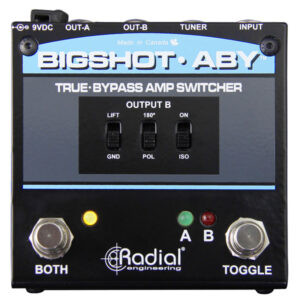
BigShot ABY
True-Bypass Switcher
The Radial BigShot ABY is a true-bypass ABY switcher that toggles or combines two guitar amplifiers in phase and without hum & buzz caused by ground loops.
](https://www.radialeng.com/product/bigshot-aby)
Alt text: Radial BigShot ABY passive guitar amp switcher pedal, showcasing its compact design and true-bypass feature.
The BigShot ABY exemplifies a compact passive switcher, ideal for straightforward amp switching needs. When using a passive aby guitar pedal to run two amps at once, it’s important to understand that the signal strength to each amplifier is halved, similar to using a Y-splitter cable.
Active ABY pedals, conversely, require power to function, much like most standard effects pedals. These pedals incorporate a buffer or a unity-gain amplifier within their circuitry. This buffer plays a crucial role in maintaining signal strength and reducing impedance. A lower impedance signal is less susceptible to noise, especially over longer cable runs. Furthermore, the capacitors within the buffer of an active aby guitar pedal can block unwanted noise originating from the amplifiers from feeding back into your guitar signal. The Radial Twin-City and Switchbone are excellent examples of active ABY switchers.
True-Bypass in ABY Pedals: Transparency vs. Switching Noise
True-bypass is a feature often touted in pedal design, and it’s relevant to aby guitar pedals as well. A true-bypass pedal, when disengaged, completely removes its internal circuit from the signal path. The intention is to preserve the original guitar tone without any coloration or loading effect on the pickups that could alter the clean sound. For purists, this transparency is a significant advantage. The BigShot ABY, for instance, is a true-bypass aby guitar pedal.
However, true-bypass designs can sometimes introduce switching noise. This “popping” sound occurs because of the physical, hard contact nature of the footswitch and internal relays when activated. This noise is typically more noticeable with high-gain amplifier settings, where any added noise is amplified significantly.
Active Switching: The Buffered Advantage
Active switching, often found in buffered aby guitar pedals, offers solutions to the noise issues sometimes associated with true-bypass. By utilizing a buffered circuit, engineers can carefully manage the signal path to minimize or eliminate switching noise. The Radial Twin-City, for example, employs electronic switching to achieve quiet transitions. The Switchbone takes it a step further with opto-couplers – photoelectric chips that smoothly ramp the signal up and down, creating exceptionally quiet switching. This type of sophisticated switching inherently requires a buffered signal.
[ 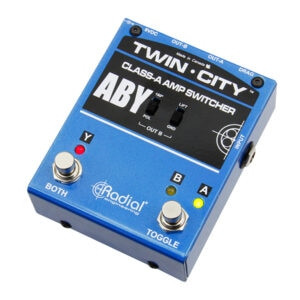
Twin-City
Active Amp Switcher
The Twin-City is an active ABY switcher that toggles or combines two guitar amplifiers in phase and without noise, with a class-A input buffer to drive both amps without any loss of gain.
](https://www.radialeng.com/product/twin-city)
Alt text: Radial Twin-City active guitar amp switcher pedal, highlighting its noise-free switching and class-A buffer for optimal signal drive.
[ 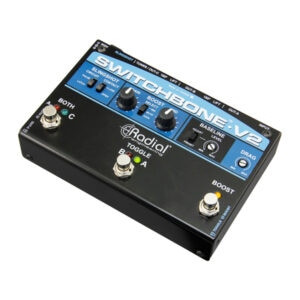
Switchbone V2
Amp Switcher & Booster
The Switchbone V2 is a feature-packed ABY pedal that also features a third output to allow switching between up to three amplifiers without noise.
](https://www.radialeng.com/product/switchbone-v2)
Alt text: Radial Switchbone V2 advanced guitar amp switcher and booster pedal, emphasizing its third output and noise-reducing opto-coupler technology.
Understanding Buffer Types: IC vs. Class-A Discrete
Within active aby guitar pedals, buffer designs can vary, primarily falling into two categories: integrated circuit (IC) based and discrete Class-A. IC buffers are common due to their efficiency, packing thousands of transistors into a tiny chip to achieve high gain. However, some guitarists find that IC buffers can negatively impact tone, sometimes describing the sound as becoming harsh or sterile. This is often attributed to the use of negative feedback in IC designs to control gain, which can alter the signal in undesirable ways. This is a common complaint with some wireless guitar systems that utilize IC buffers.
In contrast, high-quality active aby guitar pedals like the Twin-City and Switchbone utilize 100% discrete, Class-A circuitry for their buffers. This approach uses individual transistors for each gain stage, minimizing the need for negative feedback. Class-A designs are known for their purer signal path and more transparent sound, preserving the warmth and nuances of the guitar tone.
Load Correction: Reclaiming Your Amp’s Natural Tone
Even with excellent buffer designs, some guitarists perceive a slight “too clean” quality when using buffered signals. To address this, Radial Engineering developed Drag Control. This innovative load correction circuit compensates for the potential “overly clean” signal path introduced by buffering. Drag Control effectively emulates the natural interaction between a guitar pickup and a tube amplifier, including the subtle roll-off characteristics of guitar cables and the specific load presented by a tube amp – a load that differs significantly from that of a solid-state amplifier. For those seeking to fine-tune their buffered signal, consider exploring devices like the Radial Dragster, a dedicated load correction tool.
Eliminating Ground Loops: Taming the Hum and Buzz
Ground loops are a frequent headache when using multiple amplifiers, often manifesting as hum and buzz. This noise arises when two or more amplifiers are connected and share both an electrical ground and an audio ground simultaneously. The severity of the ground loop noise can vary depending on the amplifiers themselves, the building’s electrical system, and other sources of electrical interference.
A primary step in mitigating ground loops is to ensure all amplifiers and pedals are powered from a single power strip. This helps ensure they are operating on the same electrical phase. However, this is often insufficient to solve ground loop issues, which stem from differences in voltage references and grounding schemes between amplifiers.
Transformer Isolation: A Robust Solution to Ground Loops
To effectively break ground loops, transformer isolation is employed in many high-quality aby guitar pedals. A transformer acts as a magnetic bridge between the input and output, consisting of two wire coils wrapped around a core. When an audio signal passes through the primary coil, it creates a magnetic field in the core. This magnetic field then induces a corresponding electrical current in the secondary coil. Crucially, while audio signals are transmitted magnetically, direct electrical current and stray noise are blocked. This magnetic isolation effectively breaks the audio ground connection, eliminating the ground loop and the associated hum and buzz. The Twin-City and Switchbone incorporate transformers on their output-B specifically for this purpose. The BigShot ABY also features a transformer that can be engaged in the signal path to combat ground loops. However, because transformers are passive components, they can introduce some signal loss. Therefore, using a buffered signal before the transformer, as is the case in active ABY pedals, helps to maintain signal integrity.
Phase Alignment: Ensuring a Full, Rich Sound
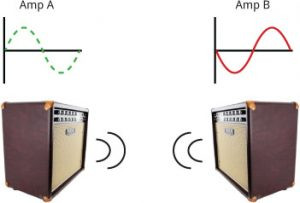 phase-amp-1_360
phase-amp-1_360
Alt text: Diagram illustrating in-phase and out-of-phase amplifier signals, demonstrating how phase alignment impacts sound fullness and clarity when using two amps.
When running two amplifiers together, phase alignment is critical for achieving a full and cohesive sound. “In phase” means that both speaker cones are moving outwards (or inwards) in unison, reinforcing each other’s sound waves. If the amplifiers are “out of phase,” one speaker will be pushing outwards while the other is pulling inwards, resulting in a cancellation of certain frequencies, and a thin, “hollow” sound. If you notice a lack of fullness or a distant quality when using two amps simultaneously, they are likely out of phase.
Many aby guitar pedals, including the BigShot ABY, Twin-City, and Switchbone, are equipped with a 180º phase switch. This switch inverts the polarity of one output, bringing the amplifiers back into phase and restoring a full, rich combined tone. Transformer isolation is often necessary to implement phase reversal effectively.
Switching Noise Revisited: Pops and Clicks
As mentioned earlier, true-bypass switches can produce audible pops or clicks during switching. This is due to the abrupt electrical contact made by the footswitch or relay. While transparent when bypassed, this switching noise can be undesirable, especially with high-gain amps. The BigShot ABY, being true-bypass, may exhibit this characteristic.
Electronic switching, as used in the Twin-City, offers a solution by using electronic circuits to control the switching process. This buffered approach allows for smoother, quieter transitions, eliminating the loud pops. The Switchbone, with its opto-coupler technology, represents an even more advanced approach, achieving virtually silent switching by smoothly ramping the signal up and down. Opto-couplers, while more expensive, provide the ultimate in quiet switching performance.
Electrical Safety: A Paramount Concern
A critical safety note when using guitar amplifiers, especially in multi-amp setups, is to never disconnect the U-ground (grounding pin) on your amplifier power cords. While some might be tempted to lift the ground to reduce noise, this practice is extremely dangerous. The ground connection is a vital safety feature, protecting you from potentially lethal electrical shocks, especially in environments like wet stages or situations where electrical faults might occur between lighting or PA systems and your guitar rig. Reputable manufacturers like Radial Engineering prioritize safety in their aby guitar pedal designs, addressing noise issues without compromising electrical safety.
Using an aby guitar pedal can significantly expand your sonic possibilities, allowing you to harness the unique characteristics of multiple amplifiers. By understanding the differences between passive and active designs, the benefits of buffering and transformer isolation, and the importance of phase and safety, you can confidently incorporate an aby guitar pedal into your rig and enjoy a world of new tonal combinations. Have fun exploring the possibilities!
